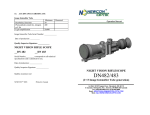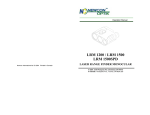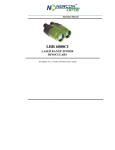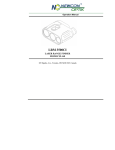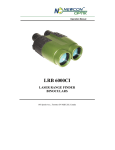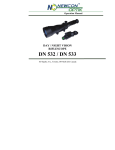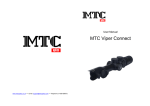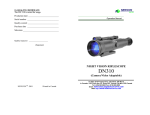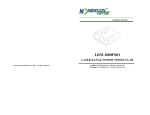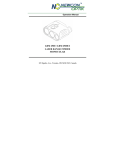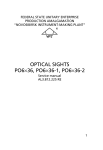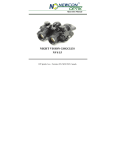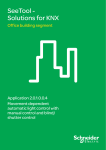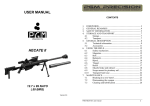Download DAY/NIGHT VISION RIFLESCOPE
Transcript
Operation Manual DAY/NIGHT VISION RIFLESCOPE DN510 105 Sparks Ave., Toronto, ON M2H 2S5 Newcon International ltd. © 2010 Printed in Canada IMPORTANT INFORMATION Read prior to activation You have just purchased a complicated electronic device. To operate it properly, please read this manual carefully. Here are some common precautions that must be noted. • NEVER disassemble the unit. This device contains high voltage, which may be hazardous to your health! • NEVER aim active unit at intense light sources (i.e. lights, headlamps, campfires, the moon, etc.) 15. QUALITY CERTIFICATE The DN 510 is suited for usage. Production date ____________________________ Serial number _____________________________ Quality control ____________________________ Purchase date _____________________________ Salesman _________________________________ • NEVER reverse the polarity of a battery • NEVER connect the unit to external power sources • ALWAYS remove batteries when not in use for a long period Quality inspector ____________________ (Signature) • ALWAYS keep the objective lenses covered when not in use • ALWAYS store in a warm dry place when not in use FEATURES OF A DN 510 NIGHT-VISION SCOPE All known models of day/night scopes with removable eyepieces use standard optic scheme of a day-vision scope with 11-13 lenses. As a rule, light ratio of such system at low sight magnification is defined not by an objective lens diameter, but by a light ratio of an erecting system (4 lenses). The actual F-number of all system does not exceed 3.0, which is clearly not enough for night-vision equipment. In addition, usual daytime scopes have relatively small eyeshot angles. Due to that reason in a night scope only centre of the electronic tube working area is used. 2 19 13. WARRANTY NEWCON OPTIK warrants this product against defects in material and workmanship for one year from the date of the original date of consumer's purchase, but no more than 18 months from the date of manufacturing. Should your Newcon product prove defective during this period, please bring the product securely packaged in its original container or an equivalent, along with proof of the date of original purchase, to your Newcon Dealer. Newcon will, replace or repair (or at its option replace), the product or part thereof, which, on inspection by Newcon, is found to be defective in materials or workmanship. What This Warranty Does Not Cover: NEWCON is not responsible for warranty service should the product fail to be properly maintained or fail to function properly as a result of misuse, abuse, improper installation, neglect, damage caused by disasters such as fire, flood, lightning, improper electrical current, or service other than by a NEWCON Authorized Service. Postage, insurance, or shipping costs incurred in presenting your NEWCON product for warranty service are your responsibility. Please include a check or money order made out to NEWCON OPTIK for the amount of $10.00 to cover shipping and handling. 14.CUSTOMER SUPPORT Should you experience any difficulties with your Newcon OPTIK product, consult the enclosed manual. If the problem remains unresolved, contact our customer support department at (416) 663-6963 or Toll free at 1-877-368-6666. Our operating hours are 9am-5pm, Monday - Friday, standard East time. At no time should equipment be sent back to Newcon without following the instructions of our technical support department. Newcon accepts no responsibility for unauthorized returns. To locate the NEWCON Authorized Dealer call: Tel: (416) 663-6963 Fax: (416) 663-9065 Email: newconsales@newcon-optik.com Website: www.newcon-optik.com The defective products should be shipped to: In USA: 2331 Superior Ave. Cleveland, OH 44114 In Canada: 105 Sparks Ave., Toronto, ON M2H 2S5 Canada 18 The DN 510 uses a specially designed unique optical scheme (23 lenses) that provides a 2-2.5 stronger light ratio, twice wider field of view and complete resolution capability using the whole working area of the electronic tube. All this in combination with a powerful generation II or III image intensifier tube provides comfort and perfect visibility both at daytime and night-time under conditions of low light, when other day/night scopes do not work any more. CONTENTS 1. 2. 3. 4. 5. 6. 7. 8. 9. 10. 11. 12. 13. 14. 15. Brief description External appearance of the device Technical characteristics Supplied accessories Using the device at day-time Using the device at night-time Battery installation Installing on a hunting rifle Adjusting the scope Taking photos and video shooting Storage and maintenance instructions Trouble shooting Warranty Customer support Quality certificate BEFORE USE CAREFULLY READ THE STORAGE, MAINTENANCE AND INSTALLATION INSTRUCTIONS! FAILURE TO OBEY THE INSTRUCTIONS WILL VOID THE WARRANTY. 3 1. BRIEF DESCRIPTION 12. TROUBLE SHOOTING Your DN 510 device is a universal hunting scope, intended for observation and hunting both at daytime and night time. The scope does not work. Check that the battery is installed properly. Check the charge of the battery. Replace if it is weak. Do not use old battery with a new one. The device is universal due to removable eyepiece. Day The day-time part employs a specially designed powerful optic scheme (23 lenses) with day eyepiece, providing 3.0 to 6.0 times magnification, F-number of the system reaches 2.0 (at 3.0x magnification) and visual angle from 12 to 5.2 degree. Night The nighttime scope employs 2nd or 3rd generation image intensifier tube (18mm, MCP), working on a principle of amplifying of available light in the visible and close infrared range. Together with the high-light-ratio day-time channel the device provides night-time range of 400-800м, system magnification 3.7 to 7.3 times and visual angle 12 to 5.2 degree. The image does not appear in focus. Bring the inspected object to the center of the image. Turning the objective lens ring (10), and/or the eyepiece (2, 8) adjust to achieve the clearest image on the screen. Repeat the steps of focusing if necessary. If the view still does not seem in focus, clean the lenses, they could be foggy or dusty. Reticle is not in focus (Parallax phenomenon). It occurs in optical sights when observing the objects on a distance different from one the objective lens is set on. It appears as a displacement of the reticle from the initial aiming point due to the shooter’s eye’s displacement from the aiming axis. To eliminate the parallax objectives lenses of optic sights are designed such that they may be refocused for a shooting distance. Parallax does not happen in nightvision scope. No picture in the nighttime channel. When bright light gets into the objective lens of the night vision device it may result in disappearing of the image as the automatic shut-off feature comes into action to protect the device. Whenever this happens, turn the switch to the OFF position. In a minute or two the device will be ready for further operation. If the image has been lost at the moment of a shot, check contacts in the battery compartment. Black dots on the Nighttime channel screen These are the cosmetic blemishes in the image intensifier, which do not affect the performance, or reliability of a night vision device and some number of varying sizes are inherent in the manufacturing process. Most of them are seen only at daytime and become almost invisible during the operation. 4 17 The TTL system, which is installed at most SLR cameras easily estimates exposure during the shooting with the device. If your camera is not equipped with the TTL system, the table can approximately estimate the shutter speed at the diaphragm number of the camera equal 2.0: 2. EXTERNAL APPEARANCE OF THE DEVICE 1 3 2 7 1 ----------------------------------------------------------------------------------ISO, 50 100 200 400 800 1600 3200 ----------------------------------------------------------------------------------Sh.speed, sec. 2 1 1/2 1/4 1/8 1/15 1/30 ----------------------------------------------------------------------------------- NOTES. Use an ISO 400 film or higher. Using of a tripod is strongly recommended to achieve higher quality photos. 11. STORAGE AND MAINTENANCE INSTRUCTIONS. Warning! After transportation or keeping the device at temperature lower than -40°c (-40°f), the device must be warmed up to ambient temperature, from -10°c (14°f) to +40°c (104°f), relative humidity of 80% max. At 20°c (68°f). DN 510 is a sophisticated precision optical instrument equipped with electronics. Therefore, it should be handled with due care. • Keep your device away from direct sunlight, impacts, dust, moisture, and sudden changes of temperatures. • Do not touch the optical surfaces with fingers. Doing so may damage the anti-reflection coating. • Cleaning of optical surfaces is possible only with professional camera lens cleaning supplies. • To clean the exterior of the device, use a soft clean cloth. • Do not take the cover off the lens if not necessary. • Keep away from heating appliances and central heating. • Make sure to switch off the unit during periods of non-operation and when storing the device for long period of time. • Do not apply superfluous efforts at work with lens assembly, agile elements and thread connections. 16 4 10 5 6 9 8 1 – Infrared illuminator; 2 – Night eyepiece; 3 – Bayonet button; 4 – Flip-open cover; 5 – Aiming mark adjustment; 6 – Mount; 7 – Magnification ring; 8 – Daytime eyepiece; 9 – Rubber eyepiece guard; 10 – Objective lens ring. 3. TECHNICAL CHARACTERISTICS Day General Magnification, x Field of view, degree Objective lens Focus length, mm F-number (for 3.0x magn.) Focus range Eyepiece Focus length, mm Eye relief distance, mm Diopter setting Mechanical characteristics Overall length, mm Weight, kg Working conditions Temperature range Relative humidity Night 3.0-6.0 3.7-7.3 12 to 5.2 100 2.0 10 m to infinity 33 27 45 +2, -4 225 0.97 226 1.10 -40 oC to +50 oC 0 to 98% 5 10.TAKING PHOTOS AND VIDEO SHOOTING Electrical parameters (Nighttime channel) Power supply 1 lithium battery of SRI123А type 3 30 3V (2 AA batteries) Voltage, V Continuous work time, h, minimum I/R illuminator Image intensifier tube Photocathode sensitivity, μA/lm Mode DN-510-A Gen. II Mode DN-510-B Gen. II Mode DN-510-C Gen. II mode DN-510-D Gen. III Gain Resolution, pl/mm 240 450 600 1,800 20,000-30,000 30-55 Infrared illuminator (optional) Power, mW Illumination angle, degree Illumination Spectrum, nm P.S. 75 or 200 8-10 805 Technical characteristics may be improved without prior notice. 4. ACCESSORIES DN510 is supplied in the following assembly: - Device - Daytime eyepiece - Nighttimes eyepiece - Rubber eyepiece guard - Objective cover - Rifle mount - User’s manual - Warranty card - Case Optional accessories: - Infrared illuminator –75 or 200 mW - Camera/video adapter (52mm/37mm) 6 1 pc. 1 pc. 1 pc. 2 pc. 1 pc. 1 pc. 1 pc. 1 pc. 2 pc. 1 pc. 1 pc./each DN 510 can be supplied with an optional adapter for photo/video devices for night photo/video shooting. Night photo shooting with DN 510 is easily performed using 35mm SLR cameras such as Nikon, Canon, and Pentax etc. with standard objective lens (50-58 mm focus). VIDEO Preparation of the device for photo shooting: 1. Screw the adapter ring supplied in the set (diameter 52mm or 37mm) into the setting place of the light filter of the objective lens in your camera. (If the objective lens of your camera has another setting diameter for a light filter (for example, 49mm or 58mm) your have to purchase step up or step down adapter rings from the 52 mm to your size). Such adapters are typically sold at camera stores. 2. Remove the rubber eyepiece guard from the scope. 3. Set the eyepiece in the medium position. 4. Screw the adapter ring with the camera in an internal groove of an eyepiece. 5. Switch on the device and focus the assembled system with the help of the objectives of the device and camera. If the image cannot be focused the camera with the ring should be removed and the coupling of the eyepiece of the device should be rotated a little. Assemble the system again and check its focusing. At some position of the eyepiece and objective of the camera the system will be focused exactly; 6. Fasten the adapter ring with the camera to the body of the eyepiece of the device with the help of three locking screws. During further photo shooting sharpness of the system is obtained with the help of the objective of the DN-510 only; 7. Set diaphragm on the objective of the camera equal 2.8 or 4 (shooting is possible even at lower diaphragm indices, for example 2, but the obtained pictures will have worse resolution). Taking photos with a completely opened diaphragm of the objective is justified for the shooting of quickly moving objects only. 15 4. Direct the rifle to the point of aiming by mechanical sight (bead with a slot) (if it is possible). At this stage it is suitable to apply laser of cold test shooting (LCTS) inserted in the barrel of the rifle, which indicates geometrical point of the barrel position (sold separately). 5. Unscrew the protective caps of Up the bias screws of the aimed Down graticule. Turning the bias Right screws of the reticle obtain the matching of reticle crosshairs with the aimed point, set by the Left mechanical sight or LCTS; 6. Remove the rifle from scoped machine and take out LCTS; 7. Make 2-3 shots. Having examined the target make necessary corrections (for example, in order to move the hit point downwards and leftwards, screws of the mechanism should be turned counter clockwise, in the directions Down and Left correspondingly. The aiming point is moving upwards and rightwards); 8. Make a control shot and find out whether the aiming point coincides with the bullet hit point. (Make the correction again if necessary); 9. Set the protective caps into their places. The device is ready for operation. The marking displacement mechanism is equipped with a click holder that displaces the marking both in vertical and horizontal direction. One click equals 12.5 mm shift of the marking at the distance of 100 m (0.45” at 100 yards). Newer versions have 1/4 MoA (minute of Angle) adjustments. 14 5. USING THE DEVICE AT DAY-TIME During the bright time of the day: 1. Install daytime eyepiece on the device. In order to do this, match white dots at the device and daytime eyepiece. Insert the eyepiece into the bayonet on the device, PRESS device and eyepiece together and turn clockwise till the red dot on the device matches the dot on the eyepiece (approximately 10 degrees). 2. Take the objective cover off. 3. Rotate the eyepiece till you get the reticle in focus. In order to eliminate parallax with the help of the focusing ring of the objective lens set approximate observation range (observation range in metres is indicated). Focusing ring 4. With the help of magnification ring set the desired device magnification. Device is ready for observation. RECOMMENDATION. It is advisable to perform device adjustment at maximum magnification. 7 6. USING THE DEVICE AT NIGHTTIME Must be done only during the dark time of the day: 1. Take off the daytime eyepiece. In order to do this press the bayonet button, turn the eyepiece counter-clockwise. Pull the eyepiece out, some effort might be required, since a vacuum is created because of water-resistant design. 2. Install nighttime eyepiece in the same manner, in which daytime eyepiece is installed. 3. Install the battery as it is indicated by the rules (see battery installation paragraph). 4. Take off the objective cover. 5. Turn on the device – switch position ON. 1-10 seconds later greenish fluorescence will appear on the screen (passive mode). 6. Rotate the eyepiece till you get the reticle in focus. 7. Turn the focusing ring till you get the maximum definition of the picture. 8. With the help of magnification ring set the desired device magnification. 9. If you need to illuminate the observed object, install and switch on the infrared illuminator (active mode). 10. After the end of work turn the switch to OFF position. 11.After you finish working with the device, close the objective with the cover. Do not forget to switch the device off after end of WORK! Warning! Do not use nighttime channel at daytime. Do not aim working nighttime device at bright objects: bright lamps, the Sun, welding, etc. – that may cause decrease of the device brightness amplification coefficient. In order to eliminate the phenomenon of photocathode fatigue do not leave night-time device switched on in the same position for more than 30 minutes at the time when the light is bright (in the morning, at day-time and in the evening). 8 • Insert the grippers (6) and gripper screws (7) into the bushings (4, 5). For stiff fixation tighten the screws (6, 7). In case of need the excessive front part of the mount (3) may be removed. Installation is completed and the device is ready for use as a hunting scope. ATTENTION! In case you use other type of binding, to eliminate the phenomenon of shooting point displacement, device binding should be advised with Newcon Optik, because usually such displacement is caused by unqualified installation. 9. ADJUSTING OF THE SCOPE Before the adjustment of the sight its objective should be adjusted for a distant object (select infinity) in daytime or a dark time with the opened cover of the objective. The adjustment of the sight should be performed only for the daytime scope. The change of the eyepiece does not affect the sight adjustment. The sight should be adjusted using the adjusting target or a remote point. Adjustment of the sight is performed in the following way: 1. Fix the scope on the rifle. 2. Set a panel with a target or select the point of aiming. 3. Set the rifle on the scoped machine. 13 Installation of the device should be performed according to the following rules: • Check the prominence of fixation screw (2) that bind the rail (3) to the body of the device over the top surface of the mount. The prominence must not be less than 2.5 mm or more than 3.0 mm. This is especially important if in the body of the device there is a dead threaded hole. For the reach-through holes the prominence may reach 3.5 mm, but must not be less than 2.5 mm. In order to meet this requirement you can cut the threaded part of the screws at length; • Prepare the glue according to an instruction (the glue need to be of a certain strength not less than 200 kg/cm2, for example epoxy) and apply it to (A) surface of the mount. The surface of the screws must remain free of the glue. This is especially important for possibility to repair the device or to remove the binding mount for installation on a different rifles; • Apply hermetic (silicone type) to the threading of the screws (2); • Fix the mount to the body of the device with the help of the screws (2), cut to meet the needed length; • Remove excessive glue (that is pushed out in the points the mount is connected to the body of the device) with the help of dry cloth and alcohol-moistened cotton wool, and let the glue take according to its instruction (for example, 24 hours for epoxy); • Locate the device on the rail of the rifle so that your eye will meet the edge of the eyeshade of the device or will be 2-5 cm apart for big calibres (like .375 H&H Magi). The position of the device must be comfortable enough so that you would not have to reach forward for convenient observation; • Insert the bushing (4, 5) into the bar (3) holes. The bushing (4) is inserted with the (В) cog pointing downward into the closest groove on the rail of the rifle. If there is no such groove, then the bushing (4) is inserted with the (В) cog pointing upwards. It is recommended that the bushings will be installed at the maximum possible distance from each other; 12 7. BATTERY INSTALLATION Night channel of DN510 device needs one SRI123A Lithium type battery. Make sure that it is in good condition and polarity is installed as it is indicated on the body of battery compartment (plus inside the device). In order to change the battery open the cover of battery compartment and install the new battery, observing polarity. When using the optional I/R illuminator, you need to install 2 AA batteries in the illuminator. Follow similar procedure. 8. INSTALLING ON A HUNTING RIFLE Night-vision device DN 510 may be used as daytime or nighttime hunting scope. RECOMMENDATION. The usage of day and/or night vision riflescopes for hunting may be limited or illegal in your area. Please, check with local authorities prior to usage. Device may be used with various mounts: 1. Standard prism – SP130-DN-510. 2. Weaver 7/8’’ rail - WP135-DN-510. That facilitates reliable fixation of the device to a particular rifle. For convenient installation the device is supplied without stiff fixation of the binding to the device, and in most cases that enables to perform the device installation to a specific rifle model. For installation you should contact a specialised armourer workshop (gunsmith) or – if you are qualified enough – perform the installation yourself. 9 • INSTALLATION RULES Variant I – Adapter rail with Standard prism type (*) – SP130-DN-510. Device is fixed with the help of the following parts: 1 • • • 2 5 A 4 3 1 – Device body. 2 – Front cradle for Standard prism. 3 – Rear feet for Standard prism. 4 – Mount of the Standard prism type. 5 – Fixing screws. (*) – According to Ernst Apel GmbH (Germany) catalogue Front and rear feet (2, 3) are the standard feet with Standard prism (4), manufactured by the companies that produce the mounts (for example, Ernst Apel Gmbh (Germany)). The mount of Standard prism type (4) and screws (5) are optional. Installation of the device should be performed according to the following rules: • Check the prominence of fixation screw (5) that bind the prism (4) to the body (1) of the device over the top surface of the prism. The prominence must not be less than 2.5 mm or more than 3.0 mm. This is especially important if in the body of the device there is a dead threaded hole. For the reach-through holes the prominence may reach 3.5 mm, but must not be less than 2.5 mm. In order to meet this requirement you can cut the threaded part of the screws at length; • • • Install the feet onto the rail (4). Insert the feet (2, 3) in the rifle. Sliding the rail in the feet, find the position, in which your eye will meet the edge of the eyeshade of the device or will be 2-5 cm apart for big calibres (like .375 H&H Mag). The position of the device must be comfortable enough so that you would not have to reach forward for convenient observation; Cut the excessive part of the rail (4); Keeping the chosen position of the device, fix the feet (2, 3) to the rail (4) according on the instruction of the feet producer; Prepare the glue according to an instruction (the glue need to be of a certain strength not less than 200 kg/cm2, for example epoxy) and apply it to (A) surface of the rail. The surface of the screws must remain free of the glue. This is especially important for possibility to repair the device or to remove the binding rail for installation on a different rifles; Apply hermetic (silicone type) to the threading of the screws (5). fix the bar to the body of the device with the help of the screws (5), cut to meet the needed length; Remove excessive glue (that is pushed out in the points the rail is connected to the body of the device) with the help of dry cloth and alcohol-moistened cotton wool, and let the glue take according to its instruction (for example, 24 hours for epoxy). Installation is completed and the device is ready for use as a hunting scope. Variant II – Adapter rail with 7/8’’Weaver rail. - WP135-DN-510 type. Device is fixed with the help of the following parts: 1 1 – Body of the device 3 – Adapter rail 7/8’’Weaver rail, including: 2 – Fixation screws; 4 – Arresting bushing; 5 – Bushing; 6 – Grip; 7 – Grip screw. (All binding details are optional). 4 B 10 6 7 2 A 3 5 11











